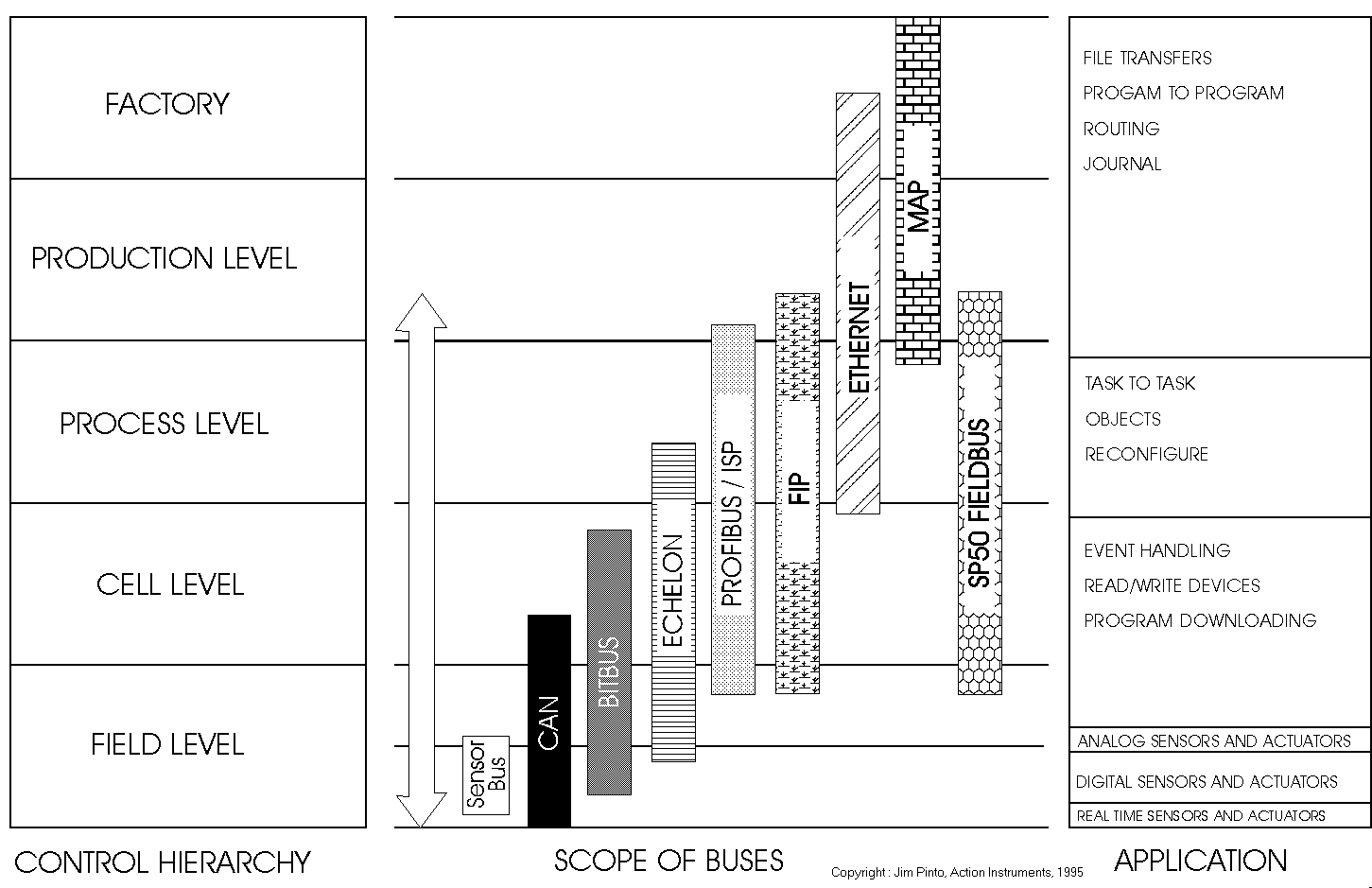|

This paper presents the perspective of a neutral third-party-supplier on the proposed SP50 Fieldbus standard.It compares the purportedly-interim standards - WorldFIP and ISP - which splintered-off and then re-combined into the Fieldbus Foundation. It brings into focus the recently introduced lower-level industrial networks, LON and CAN-based, which come pretty close to doing what Fieldbus is supposed to do.
What does all this confusion and conflict mean? What is the true "need" for Fieldbus? Why does it remain bogged down in endless discussion? The inevitable comparison with the fate of the stalled MAP (Manufacturing Automation Protocol) standard brings up fundamental questions of commercial viability against competitive de facto-standard alternatives.
A "standard" benefits manufacturing-orientated organizations, like the Japanese and Taiwanese, who can produce volume. It is interesting to note that very few VCRs or FAX machines are manufactured in the USA, simply because the standards have yielded high-volume commodity products which benefit only the far-eastern manufacturing-based cultures. Americans and Europeans must necessarily focus on specialty products with at least some market-differentiation which allows higher margins and relatively immediate commercial returns.
A "standard" is intrinsically a "bureaucratic" thing that obsoletes itself in the present-day fast-moving technological environment. The realities of a practical economic environment demonstrate that no one is really willing to pay the price for a standard, when performance is available at a fraction of the cost. The only "standard" possible in the Industrial Instrumentation business is one that emerges as "de facto". This means,, during the shake-out stages, there wont be just one "standard" vying for dominance, but more like a "few". The interesting (and all-too-obvious) thing about interoperability is that, while it is a strong attraction for users, it is obviously a negative for suppliers who must use their best marketing wiles to remain proprietary. No sane marketing strategist would wish to fritter away precious product-differentiation with vulnerability to "openness".
The more recent (March '94) introductions of DeviceNet by Allen-Bradley and SDS (Smart Distributed System) by Honeywell Micro Switch, both CAN-based, both claiming to be "open", and both strongly vying for third-party-vendor involvement, demonstrates the marketing thrust for "de-facto" leadership. Indeed, there is a definite linkage between this marketing battle and the Fieldbus wars, pointing out that the world will not wait for a political fiasco to be played out.
Figure 1 illustrates the relationship between Fieldbus and the other bus networks in the industrial automation environment. Fieldbus occupies the top right corner, presently available sensor/actuator bus is at the lower left, and the new CAN-based networks bridge the vast expanse in between. It seems likely that, within the next few years, the CAN-based protocols will expand, almost by default and "osmosis" into the purported domain of Fieldbus, obviating the need for the more complex standards. The lower cost and equivalent performance of the CAN-based networks, combined with marketing drive from the primary vendor and extensive third-party and end-user support, seem to assure that inevitability. The marketing "trend", of course, is there for all to see: networked communications on the factory floor and in the process environment is the important next development, and no bureaucratic committee delays with "open" standards and "interoperability" will stop the wave of progress.
 Recognizing that industrial I/O networking is clearly a growth business, and hoping to generate a new de-facto standard, both Honeywell and Allen Bradley have announced "open" systems, eager to attract others in the industry to join up to create a marketing band-wagon effect. The specifications were published, though product availability (beyond capability demonstrations) still (almost a year and a half later) remains uncertain. (Ref. 3 - Pinto). Interestingly, Allen Bradley put DeviceNet into a totally separate (from Allen Bradley) booth at several of the recent major exhibitions. They have stated their intention to create a separate organization, to guarantee openness and interoperability and have formed a new legal entity - ODVA - Open DeviceNet Vendors Associatio, to which they have given the rights and powers to implement DeviceNet interoperability. This is somewhat similar to the European PTO - Profibus Trade Organization - which is dominated by Siemens and supported by many European vendors, who guarantee interoperability. Silicon Chips - Availability & CostThe price of silicon chips is dependent size (of the chip) and sheer unit volume. The industrial automation business is extremely fragmented, with very few products that literally sell in the millions. Silicon chips used in industrial controls typically cannot support volumes beyond a few hundreds of thousands, and hence silicon designed specifically for industrial products cannot achieve a pricing level which compares with consumer products. Therefore, the best alternative for designers of industrial controls is to "piggyback" on chips which are already utilized in high volume in other markets.Echelons LON technology was considered by both Honeywell and Allen Bradley, among others, for low-level industrial networking, and still remains a viable candidate in the background. LON is already being considered for extensive use in home and building automation markets, and the LON chip, manufactured by Motorola and Toshiba, is already available in high quantity at a price of about $5. However, based on speed of response (best-case about 10mS), both companies settled on CAN - Control Area Network - as the technology of choice for this important new product and marketing thrust. The CAN chip is used extensively in the automobile business to eliminate wire-harnesses. The chips are manufactured by Motorola, Intel, and others, with volume already yielding cost at about $3-5 in reasonable quantities. At the Fieldbus level, both WorldFIP and ISP claimed to have silicon available, though price and performance was still at a very early stages of development. As soon as the merger into the Fieldbus Foundation was announced, the ISP chip-sets became a curiosity and vendors who had a stake in that silicon simply lost their investment. On the other hand, WorldFIP affiliates continued to market their wares, with dampened, but undiminished enthusiasm, especially in France where the technology originated. Recognizing that "higher-level" Fieldbus is significantly more complex, with the added burden of the politics of committee-cooperation, it is unlikely that silicon will be available at anywhere near the cost which justifies general application in "low level" industrial networking. This limitation also inhibits increase of volume. In any case, under the best of circumstances, total worldwide unit volume is unlikely to exceed 1 million, which is a relatively small quantity in the silicon production environment. Also, the chip (at least initially) will be relatively large in size, which keeps the price relatively high (perhaps $25). For these reasons, Fieldbus is relegated to the deferred and amorphous "higher level". The Choice Between the BusesThe chart in Figure 2 shows the application scope of several buses in the broad horizons of the industrial automation and process controls markets. It is evident that Fieldbus has some value at a level of complexity that is beyond simple sensors, actuators and I/O devices. However, it is equally evident that the lower level buses, such as CAN and LON, will inevitably encroach into the domain of Fieldbus, while the complexity and cost of Fieldbus will inhibit downward migration.Both WorldFIP and the new Fieldbus Foundation (ISP is defunct) have stated that they will "migrate" towards IEC/SP50 when it eventually becomes a standard. This appears to be a marketing tactic, to defer to the needs of users who are demanding one standard, while at the same time moving towards interoperability with marketing allies. The reality is that very few products, even within "sub" standards (if the author is permitted to use that obvious expression) are actually interoperable. Indeed, exhibitions of interoperability demonstrations take a lot of time, money and physical effort, and prove very little in the way of performance. Some vendors (example, SMAR) actually demonstrate "fieldbus" products, presenting them as significant achievements, when in fact they miss the entire point - to be meaningful, fieldbus products must be interoperable; isolated, single-company demonstrations are entirely worthless. One wonders if any of the users are actually impressed, beyond being entertained. The industry continues to demand clear reasons why the standard contniues to be delayed, and the Fieldbus Foundation responds with logical explanations (about layers and levels) which few understand. In the meantime, Profibus had made progress to the extent that about 250,000 nodes have been installed (mainly in Europe), with some installations arriving in the US and other parts of the world primarily through German systems. This important fact must be noted - no other fieldbus product has comparable installed base and multi-vendor interoperability. Siemens had supported ISP, since it was in reality an implementation of Profibus (dominated by Siemens) with additional layers which favoured some of the others. The launch of ISP was a thinly-veiled marketing exercise, providing strong technology-advantage benefits to key particpants. When ISP lost its impetus, it was clear that Profibus would need to make a separate and independent launch in the US markets. So, the PTO budgeted a significant amount of money and has commenced a major promotions program to make a marketing launch of Profibus in the USA. Today, the industry is feeling the impact of that marketing program (Chess-pieces advertisement campaign, 1995/96).
 Figure 2 : Chart showing application scope of several buses used in the industrial environment.
It is interesting to note (Ref. 4 Hunziker) that the Building Automation business also has its equivalent of Fieldbus - BACnet (Building Automation Controls Network) which appears to be bogged down in similar committee deliberations. The comparisons of the two committees with their predecessor MAP (the Manufacturing Automation Protocol) and TOP (Technical & Office Protocols) are too close for comfort. Do the SP50 committee members and the Fieldbus Foundation participants see the similarity ?

Table I provides a direct technical comparison of some of the major contenders in the "field bus" applications environment. Some of the specifications are still the subject of debate and modification, though the overview in this format is indeed useful. The overlap is evident, and the details are subject to dispute only by ivory-tower gurus who do not realize that the combination of commercial viability and practical time-to-market far outweighs theoretical perfection. Indeed, the best choice is often the most practical, which then simply and effectively reduces to the lowest cost. As discussed above, the availability of silicon at a low price, because of use in other markets, is perhaps the biggest advantage of CAN. Fieldbus chips can never attain the volume to achieve competitive pricing. One of the significant oversights that is occurring in the discussions of Fieldbus standards is that most people are considering current distributed-control systems architectures when evaluating the requirements. The reality is that conventional central-host-based architectures are indeed obsolescent (in the process of becoming obsolete) and giving way to "truly" distributed control architectures which involve autonomous I/O in peer-to-peer networking configurations. (Ref 3) GatewaysThe reality of interoperability is a marketing dichotomy that will never really be resolved. Major vendors will show "interoperable" products, when demanded by major users, but will always inevitably retain the best performance for their own products when utilized as a family. In other words, a Honeywell valve may work with a Fisher/Rosemount system, but the best performance will be available only when that valve is used with a Honeywell system. And, of course, the reverse will be true. Some aspects of operation must, of necessity, remain "proprietary" - the fruits of "intellectual property".What will emerge is the use of "gateways" between buses and between proprietary products and open architectures. With the availability of cheap memory and processing power, it is far more practical to make a whole range of I/O products work with any bus through a gateway, without the need for converting the entire product line to operate with an "alien" bus and all its attendant hidden proprietary features. Gateways will theoretically appear to have intrinsic delays and performance limitations - but practically, can be made to operate with very little disadvantage. What Are the Real Benefits ?Lasher, (Ref. 5) a strong proponent of the need for Fieldbus, and now working for a vendor that supports WorldFIP, raises several good questions. Here is a sampling : What are the real economic benefits of Fieldbus? Will all field-devices be affected, or just transmitters? Should Fieldbus be used universally? Should the same wiring topology be used for new construction, as for retrofit? Can the questions regarding redundancy and integrity ever be agreed upon? How much re-education will be needed? Lasher reviews the situation pragmatically - recognizing that there are intrinsic dichotomies that will continue to inhibit progress.This authors opinion is that industrial networking for all factory automation and process control devices has significant benefits. A variety of bus networks will demonstrate significant benefits over the next few years, paving the way for a complete re-organization of the industrial environment based on networking of sensors, actuators and virtually everything in between. Choices are dictated by clear benefits - in business that means productivity improvements and cost savings - and not by committee agreement between market combatants. Users cannot force agreement - only practical and commercial success can. It is far more likely that the new LON or CAN networks will achieve sufficient user adoption and hence sheer volume and hence price and hence new performance to spread upwards, than it is that Fieldbus will eventually achieve adoption through consensus. PredictionsThe great debate on the IEC/SP50 Fieldbus standard will continue along the direction of its predecessor, MAP - the Manufacturing Automation Protocol. When it is finally complete, it will continue to attract lip-service and capitulation to demands by all major vendors. But, in parallel with their "interoperable" Fieldbus products, vendors will continue to offer proprietary extensions and performance improvements which will continue to defeat the underlying users need for "interchangeability".In the meantime, it is likely that at least a few "de-facto" standards will emerge - CAN and LON at the lower end, which will eliminate HART, and various Sensor and Actuator bus products, and provide connections directly into the higher level networks like Ethernet and ARCnet which will provide enterprise-level communications. Fieldbus itself will remain a useful, more complex and costly, lesser used alternative, inhibited by its dependence on bureaucratic multi-vendor committee involvement. References1/ Waterbury, Robert C. - Fieldbus Fever - Rivalry and Cooperation. - Industrial Computing, December 1993.2/ Furness, H. - Bus or Network - What is Interoperability? - Control Engineering, February 1993. 3/ Pinto, James J. - Two New Networks Target Factory-floor Devices. - I&CS June 1994. 4/ Hunziker, Robin and Schreier, Paul G. - Fieldbuses Compete for Engineers' Attention, Start Gaining Commercial Support. - Personal Engineering & Instrumentation News, August 1993. 5/ Lasher, Richard J. - Fieldbus Advancements and Their Implications. - Proc. of 1994 International Control Engineering Conference, March 1994.
  See also Fieldbus Update Dec.'99 See also Fieldbus Update Dec.'99See also Report on Fieldbus Debate ISA 99   See the poem Famous Fieldbus Vote Fiasco See the poem Famous Fieldbus Vote Fiasco |
Return to Index of all JimPinto Writings

 Return to JimPinto.com HomePage
Return to JimPinto.com HomePage
If you have ideas or suggestions to improve this site, contact: webmaster@jimpinto.com
Copyright 2000 : Jim Pinto, San Diego, CA, USA
